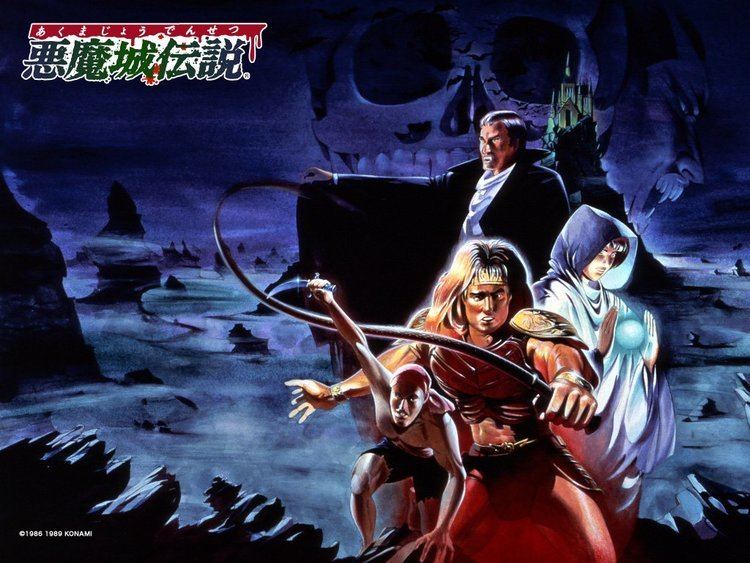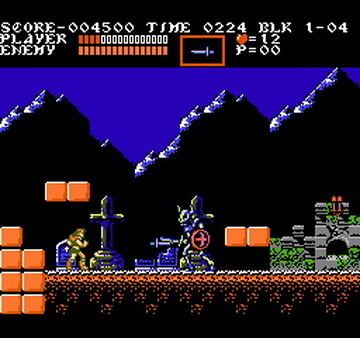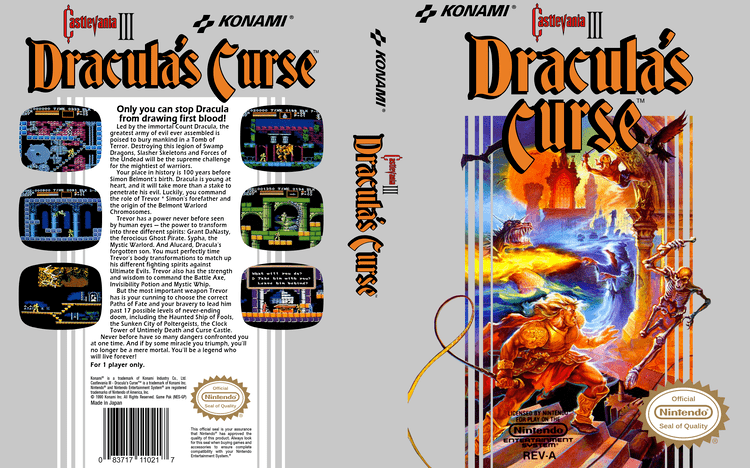9.2 /10 1 Votes9.2
9/10 IGN Director(s) Hitoshi Akamatsu Initial release date 22 December 1989 | 4.5/5 Emuparadise 4.8/5 eBay Designer(s) I. Urata | |||||||||||||||||||||||||||||||||
Programmer(s) Yasuo OkudaMitsuo Takemoto Artist(s) Noriyasu TogakushiTakeshi FujimotoI. Urata Composer(s) Hidenori MaezawaJun FunahashiYukie MorimotoYoshinori Sasaki Release date(s) NES/FamicomJP: December 22, 1989NA: September 1, 1990EU: December 10, 1992WindowsNA: November 16, 2002Virtual ConsoleWiiPAL: October 31, 2008NA: January 12, 2009JP: April 21, 2009Nintendo 3DSEU: April 17, 2014NA: June 26, 2014Wii UJP: April 16, 2014NA: June 26, 2014PAL: September 4, 2014 Similar Castlevania games, Konami games, Platform games | ||||||||||||||||||||||||||||||||||
Castlevania iii dracula s curse nes avgn episode segment
Castlevania III: Dracula's Curse, known in Japan as Akumajō Densetsu (悪魔城伝説, literally Devil's Castle Legend), is the third and final Castlevania video game produced for the Nintendo Entertainment System. It was published by Konami in Japan in 1989, in North America in 1990, and in Europe in 1992 (some time after the European release of Super Castlevania IV). It was later released on the Wii Virtual Console in the PAL regions on October 31, 2008, in North America on January 12, 2009 and in Japan on April 21, 2009.
Contents
- Castlevania iii dracula s curse nes avgn episode segment
- Castlevania iii dracula s curse w alucard video walkthrough
- Gameplay
- Plot
- Development
- Reception and legacy
- Other media
- References

The plot of Castlevania III: Dracula's Curse is a prequel to the original Castlevania (much like the earlier Game Boy game Castlevania: The Adventure) set a few centuries before the events of the original game. The game's protagonist is Trevor C. Belmont, an ancestor of the original hero Simon Belmont.

Castlevania iii dracula s curse w alucard video walkthrough
Gameplay

Castlevania III abandons the action-adventure game and role playing game elements of its immediate predecessor Castlevania II: Simon's Quest and returns to the platform game roots of the first Castlevania title. Unlike Castlevania, however, Castlevania III is non-linear: Trevor, the main character, can be assisted by one of three possible assistant characters, and after completing the first level, and at several other points throughout the game, the player is given a choice of two branching paths to follow. The player can obtain multiple endings depending on the choices they make throughout the game.

There are two main routes through the game's sixteen stages. The second stage is an optional excursion for picking up one of the three partner characters, and the main branch occurs part way through the third stage. Each route contains total of nine stages (ten if the player takes the optional second stage). The upper route takes the player across the lake to the main bridge, entering Dracula's castle through the front gate, and is generally regarded as the easier of the two routes. The lower route takes the player through a series of underground tunnels and cavernous areas, eventually scaling the cliff side below the castle, and is generally considered more difficult than the upper route. The lower route also features one short branching section of its own at stage 6. The two paths converge in the main hall of the castle.
Plot

The year is 1476, and Count Dracula has started to ravage Europe with an army of monsters. The Belmont family of vampire hunters, once exiled from Wallachia, are called into action by the Church. They feared the Belmonts' "super-human" power, but with Dracula menacing to swallow Europe in darkness, they are left with no choice but to call Trevor Belmont, current wielder of the Vampire Killer Whip.
Joining Trevor Belmont in his mission to defeat Dracula are three new playable characters: Sypha Belnades, a young sorceress with poor physical attack power but powerful elemental magic spells at her disposal; Grant Danasty, a pirate with the ability to climb on walls and change direction in mid-jump (a rare ability in earlier games of the series); and Alucard, Dracula's son, a dhampir with the ability to shoot fireballs and transform into a bat. Trevor can be accompanied by only one companion at a time. If he chooses to take on another he must abandon his current companion. The player can "spiritually transform" between Trevor and his ally with the "select" button. Both Trevor and whoever is accompanying him share the same health meter. The ending of the game differs depending on which companion Trevor has with him at the time, or if he does not take another character with him at all.
Development
Besides just the different title, Akumajō Densetsu, the Japanese version has several other differences. Most notably, the original Japanese version contained a specialized "VRC6" coprocessor chip. The game's audio programmer, Hidenori Maezawa, assisted in the chip's creation. This chip added two extra pulse-wave channels and a saw-wave channel to the system's initial set of five sound channels. The majority of the music combines the channels to imitate the sound of a synthesized string section. Western versions of the NES did not have the ability to support external sound chips, so the North American release replaced the VRC6 with Nintendo's Memory Management Controller 5 (MMC5). The MMC5 chip's sound channels cannot be used with the NES, and the game's music had to be downgraded by Yoshinori Sasaki to comply with the NES's standard five channels.
Other changes differed in the gameplay or graphics. Instead of using a stabbing dagger, Grant throws daggers as his main attack. Some enemies do less damage in the Japanese version, and had their sprites changed for the Western releases. Some instances of nudity on the enemies were also censored. The Japanese version had slightly different backgrounds in many stages, and had special effects not seen in the North American and European releases.
The North American and PAL versions have several hidden features that can be accessed by entering a certain name for the player, which include starting the game with 10 lives (by entering the name "HELP ME"), the option to start the game with any of the three spirit partners, and to access the second, more difficult quest. These features are not present in the Japanese version.
Castlevania III was the first game in the series to have different packaging artwork outside Japan, designed by Tom Dubois using alkyd. It was inspired by Ray Harryhausen. Dubois would also go on to design the North American packaging for Super Castlevania IV, Castlevania II: Belmont's Revenge and Castlevania Bloodlines.
Reception and legacy
Nintendo Power listed it as the ninth best Nintendo Entertainment System video game, praising it for its strong improvements over previous entries in the series. Game Informer's Tim Turi felt that it was a return to form after Castlevania II. He discussed characters such as Alucard (who he called iconic) and Grant (who he praised for his wall cling ability). GamesRadar ranked it the eighth best NES game ever made. The staff felt that it returned to Castlevania's roots after Castlevania II yet "took the series to new heights." GameZone ranked it as the third best Castlevania title. The staff preferred III the most as it felt like the original game the most; they felt its price on the Virtual Console was worthwhile.
The 1991 Captain N episode Return to Castlevania was based on this game.
2005's Castlevania: Curse of Darkness featured Trevor Belmont as a playable character.
IGN placed Castlevania III: Dracula's Curse 5th on their list of the Top 100 NES Games.
Other media
An animated Dracula's Curse movie is in development, and may be split into three parts. It is being produced by Frederator Studios and written by Warren Ellis, with art direction by James Jean.
Akumajō Dracula Famicom Best was a soundtrack album that included the Famicom version of the game's original music.
Film producer Adi Shankar had teased in August 2015 that he was produce an animated mini-series based on Castlevania III: Dracula's Curse. Fred Seibert and Kevin Klonde will also serve as executive producers. It was revealed in February 2017 that this series will be animated series to be show on Netflix based on the Castlevania franchise, to first air in Q4 2017.
